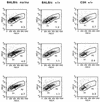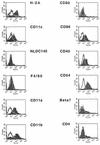Protection against ascending infection of the genital tract by Chlamydia trachomatis is associated with recruitment of major histocompatibility complex class II antigen-presenting cells into uterine tissue
- PMID: 9673231
- PMCID: PMC108384
- DOI: 10.1128/IAI.66.8.3535-3544.1998
Protection against ascending infection of the genital tract by Chlamydia trachomatis is associated with recruitment of major histocompatibility complex class II antigen-presenting cells into uterine tissue
Abstract
A mouse model of ascending infection following intravaginal inoculation with a strain of Chlamydia trachomatis isolated from humans has been used to identify immune mechanisms associated with protection against genital infection. BALB/c and C3H mice differed in their susceptibilities to infection and inflammatory disease. In both mouse strains, ascension of the organism and recruitment of bone marrow-derived mononuclear leukocytes were evident in uterine tissue 1 week postinfection. By 3 weeks the organism had been cleared and inflammation had been resolved in the BALB/c mice, but both persisted in the C3H animals. In athymic nude BALB/c mice both the organism and inflammation persisted, indicating the influence of the hosts' immune response on the outcome of infection. Both BALB/c and C3H mice had a Th1 response in draining lymph nodes, with predominant production of gamma interferon and tumor necrosis factor alpha, low levels of interleukin-10, and no detectable levels of interleukin-4. However, the composition of the early uterine infiltrate differed in these two mouse strains. Cell surface labeling and analysis of light scatter properties by flow cytometry identified a population of large, CD45(+) major histocompatibility complex class II mononuclear cells, which were a prominent feature of the infiltrates in BALB/c mice but were present in significantly lower numbers in C3H mice. These cells expressed the costimulatory molecules CD86 and CD40 and stimulated allogeneic T cells, suggesting that these mononuclear cells are a population of antigen-presenting cells and that they may play a role in clearing antigen and protecting against inflammatory disease in BALB/c mice. An additional level of immunological control may thus exist in genital chlamydial infection.
Figures







Similar articles
-
Route of infection that induces a high intensity of gamma interferon-secreting T cells in the genital tract produces optimal protection against Chlamydia trachomatis infection in mice.Infect Immun. 1998 Sep;66(9):4030-5. doi: 10.1128/IAI.66.9.4030-4035.1998. Infect Immun. 1998. PMID: 9712743 Free PMC article.
-
Local Th1-like responses are induced by intravaginal infection of mice with the mouse pneumonitis biovar of Chlamydia trachomatis.Infect Immun. 1995 May;63(5):1784-9. doi: 10.1128/iai.63.5.1784-1789.1995. Infect Immun. 1995. PMID: 7729886 Free PMC article.
-
Mouse strain-dependent chemokine regulation of the genital tract T helper cell type 1 immune response.Infect Immun. 2001 Dec;69(12):7419-24. doi: 10.1128/IAI.69.12.7419-7424.2001. Infect Immun. 2001. PMID: 11705916 Free PMC article.
-
Mouse strain-dependent variation in the course and outcome of chlamydial genital tract infection is associated with differences in host response.Infect Immun. 1997 Aug;65(8):3065-73. doi: 10.1128/iai.65.8.3065-3073.1997. Infect Immun. 1997. PMID: 9234755 Free PMC article.
-
Immunity, immunopathology, and human vaccine development against sexually transmitted Chlamydia trachomatis.Hum Vaccin Immunother. 2014;10(9):2664-73. doi: 10.4161/hv.29683. Hum Vaccin Immunother. 2014. PMID: 25483666 Free PMC article. Review.
Cited by
-
Murine MicroRNA-214 regulates intracellular adhesion molecule (ICAM1) gene expression in genital Chlamydia muridarum infection.Immunology. 2015 Aug;145(4):534-42. doi: 10.1111/imm.12470. Epub 2015 Jun 29. Immunology. 2015. PMID: 25865776 Free PMC article.
-
Immunological basis of Chlamydia induced reactive arthritis.Sex Transm Infect. 2000 Jun;76(3):156-61. doi: 10.1136/sti.76.3.156. Sex Transm Infect. 2000. PMID: 10961189 Free PMC article. Review. No abstract available.
-
Fc receptor regulation of protective immunity against Chlamydia trachomatis.Immunology. 2002 Feb;105(2):213-21. doi: 10.1046/j.0019-2805.2001.01354.x. Immunology. 2002. PMID: 11872097 Free PMC article.
-
Proteomic identification of immunodominant chlamydial antigens in a mouse model.J Proteomics. 2012 Dec 21;77:176-86. doi: 10.1016/j.jprot.2012.08.017. Epub 2012 Aug 31. J Proteomics. 2012. PMID: 22959960 Free PMC article.
-
Induction of protective immunity against Chlamydia trachomatis genital infection by a vaccine based on major outer membrane protein-lipophilic immune response-stimulating complexes.Infect Immun. 2000 Dec;68(12):6798-806. doi: 10.1128/IAI.68.12.6798-6806.2000. Infect Immun. 2000. PMID: 11083798 Free PMC article.
References
-
- Brunham R C, Kimani J, Bwayo J, Maitha G, Maclean I, Yang C, Shen C, Roman S, Nagelkerke N J D, Cheang M, Plummer F A. The epidemiology of Chlamydia trachomatis within a sexually transmitted diseases core group. J Infect Dis. 1996;173:950–956. - PubMed
Publication types
MeSH terms
Substances
LinkOut - more resources
Full Text Sources
Medical
Molecular Biology Databases
Research Materials
Miscellaneous

